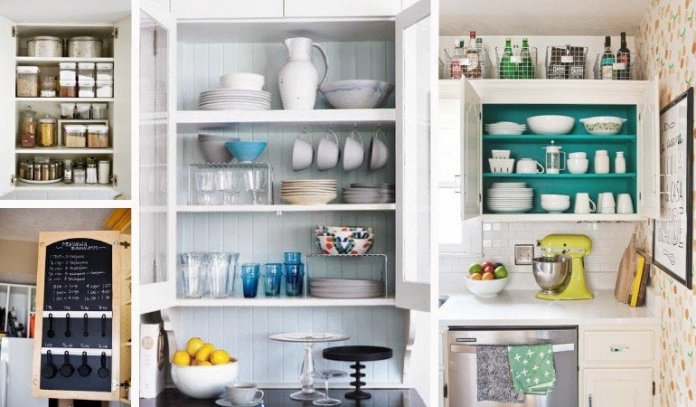Even if you don’t cook often, you can still get annoyed by disorganized and cluttered kitchen cabinets. It’s irritating having to shift things around to find your favorite glass, the one that makes every beverage taste better. And if you do cook often, you’ve probably felt that specific stress of trying to find the tongs or stirring spoon before your meal starts to burn.
Contents
The thing about messy kitchen cabinets is that they lead to messes elsewhere in your kitchen, too. Sure, you can shut the cabinet doors to hide the clutter, but if there’s nowhere to put things away, the clutter expands. Then, cleaning your kitchen becomes a hassle, too. It’s a ripple effect, but it’s not one you’ve got to put up with.
How to Declutter Your Kitchen Cabinets
If you’re ready to get your kitchen cabinets organized, read on. You’ll only need part of an afternoon to do it, but it’ll make you feel better every day. Before you can start organizing, though, you need to declutter them, so you aren’t trying to make room for a lot of things you don’t need or use.
So, open up those cabinet doors and take out everything. Use a footstool if you need one, and feel free to spread things on the floor when you run out of counter space.
The idea here is to force yourself to look at and make a decision about everything in your cabinets, so you’re not making space for clutter. Go ahead and throw out things you know at a glance are trash. Then, look through the rest to find more stuff to toss and get rid of the things below.
What to Throw Away
Expired canned goods. The date on a container doesn’t really tell you when food is no longer safe to eat. Brush up on what food expiration dates mean before you toss out stuff. But definitely get rid of any bulging or leaking cans.
Old herbs and spices. If you can’t smell an herb or spice without burying your nose in the container, then you won’t be able to taste it in your food, either. Don’t stop at tossing out stale seasonings, though. Get rid of oils that smell “off,” too– they’re rancid and will ruin your meals.
Anything that’s broken. We’ve all got broken things we plan to fix one day. If you’ve meant to fix something for months but haven’t, it’s a sign you don’t really need it.
Worn out stuff. From cracked wooden spoons to chipped glasses and ratty teatowels, you probably avoid using things that are no longer in good shape. Don’t let them take up room in your kitchen cupboards.
What to Give Away
Things that don’t fit your stage of life. For example, a 2-serving casserole dish might have been perfect when you first set up house, but it’s too small to feed a family. Or, say you quit drinking years ago. Maybe it’s time to give away those martini glasses and shakers, eh?
Specialty gadgets and uni-taskers. Maybe you used to throw fondue parties but can’t stand the thought of communal dips anymore. Or you were really into making sourdough bread, like everyone else, but no longer have time for it now that life is starting to get back to normal. It’s okay to let go of that gear.
Anything that didn’t live up to its hype. From garlic peelers that didn’t speed up the work to an indoor grill that you avoid using because it sets off your smoke alarm — if you hate using it, don’t keep it.
Gifts that make you feel guilty. Just because you didn’t pay for something doesn’t mean you have to keep it. If you don’t love seeing or using it, don’t give it space in your kitchen. Yes, that goes for the cute apron you got as a hostess gift from your best friend. She’ll understand. Really.
Duplicates. Souvenir glasses and coffee mugs multiply behind closed doors. Okay, maybe not really, but it feels that way. Pick a few favorites and part with the rest. A good rule of thumb is to have one for everyone in your home who might use it and two extra in case you have guests.
Canned or boxed foods your family will not eat. Did you buy a can of lima beans that’s just gathering dust? Maybe you stocked up on oatmeal but realize you’ll never eat all four containers before they go bad. It’s okay to let go of things, but please don’t throw good food away. Take it to a local food bank or neighbor.
How to Organize Your Kitchen Cabinets
Once you’ve purged the clutter, you’re in a much better position to see how much space you need for the things you plan to keep.
- Plan Storage Strategically
Give some thought to how you use your kitchen. What are the most accessible cupboards and drawers? You’ll want to store frequently-used things there. Which ones are challenging to use? That’s where stuff you rarely need belongs. (Pro tip: Those annoying half-cabinets above the fridge are a great place for the stash of candy you’re hiding from the kids. Or cooking utensils and serving ware that you only use for holidays.
- Unbox Dry Goods
Dry goods are things like cereal, flour, oats, or pasta. The point of transferring them to other containers isn’t about getting Instagram-worthy shelves. (Though you will.) The real reason has to do with how you keep pantry moths out of your kitchen.
Putting your food into air-tight containers protects it from household pests and helps it stay fresh. Opt for square, flat-topped clear containers: they take up less space and are stackable, plus you can see what’s inside at a glance. (I use these, which come with reusable chalkboard labels.) - Group by Function
The fewer cabinets you have to rummage around in, the tidier they’ll all stay. So, think about what you do most often in your kitchen and group together the things you use. For example, if you bake a lot of cookies, group your ingredients and decorations. If your kids take lunch to school every day, group their lunch bags, thermoses, and food containers.
Clear, unlidded bins are a great way to keep your groups tidy. Instead of going through several different cupboards searching for ingredients, liners, and decorations, you just have to grab the bin to bake a batch of cupcakes and start cooking. - Put Things Away
Below are some general guidelines about where to put things in kitchen cupboards. No law says you’ve got to store things this way — the entire point of organizing your kitchen cabinets is to make them useful to you. But it doesn’t hurt to understand why other people tend to store things where they do.
Dishes and glassware: Storing these in a cupboard near the dishwasher or sink makes it easier to put away clean ones. To keep this cabinet from feeling cramped, don’t use it to hold holiday or special occasion glassware like Christmas mugs or fancy wine glasses for guests. Either move those to a higher, less-accessible cabinet or store them in a closet.
Utensils and gadgets: If you cook a lot, you may want to keep your favorite spoons and spatulas in a crock on the counter. More into take-out? Stash the cooking utensils in a drawer, so they don’t sit there gathering dust.
Foods, seasonings, and other ingredients: Try to keep these near your stove. If you cook often, you’ll want them at eye level, so they’re easy to find. To group them, keep dry ingredients together on one shelf and canned items on another. Use a turntable or bin to hold oils and seasonings you use often.
Food storage containers: Grabbing a food storage container isn’t usually urgent, so don’t give them prime real estate near the cooktop or sink. A lower cabinet is usually fine.
Towels and potholders: Unless you have many potholders and oven mitts, hanging them is a great way to free up space — just add hooks to the side of your fridge or inside a cabinet door. Towels can get out of control, too. You need a fresh one for every day of the week and a couple of spares, so try to keep your collection down if you’re short on space. - Keep Your Kitchen Cabinets Tidy
Once you’ve decluttered and organized your kitchen cabinets, upkeep only takes a few minutes each week. Put away kitchen clutter as part of your daily tidy-up routine and straighten messes when you see them. If your kids are the ones who empty the dishwasher, you might consider labeling the shelves and drawers to help them know where things belong.
More Ideas to Make Space in Your Kitchen Cabinets
Have you purged clutter from your kitchen cabinets but still feel short on space? Here are some more ideas to maximize space in your cupboards.
Hang your pots and pans
If you’ve got a gap between cabinets above your kitchen sink, why not install a pot rack there? You’ll free up an entire cupboard and make them easy to reach, too. Plus, they can drip dry. It doesn’t have to be fancy, either. I use a half-round piece of lumber and heavy-duty mug hooks to make mine. Once I painted it, everyone thought it was an original part of the cabinets.
Reclaim wasted space
Put empty vertical space in your kitchen to work. For example, you can free up a shelf of spices by using magnetic containers to store them on the side of your fridge. Or add a knife bar to your backsplash and get rid of the bulky knife block. You don’t even have to drill holes — use a Command Strip or heavy-duty Velcro.
Add extra shelving
If you can’t install additional shelves, a wire under-shelf basket is the next best thing. On the counter, use a cake stand or tiered basket to maximize vertical storage. They’re perfect for holding produce or linens. If the end of your cabinets isn’t adjacent to a doorway, use a few adhesive shelves or hooks to turn them into storage.
Use tension rods
Install a tension rod horizontally under your kitchen sink and hang bottles of non-toxic cleaning products. Install a few vertically in a lower cupboard, and you can stash baking sheets, pie pans, and casserole dishes on their side to take up less space. Lengthwise in a drawer, a tension rod acts as a divider. They’re so useful!
Conclusion
Remember, all decluttering and home organization projects are ongoing. Don’t get locked into one setup or system just because that’s how you’ve always organized things. Your setup should change as your life changes. You’ll know it’s time to declutter and reorganize your kitchen cabinets when it’s a hassle to find what you need or put away what you’ve used.


